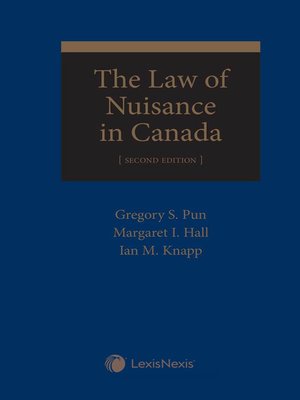
Sign up to save your library
With an OverDrive account, you can save your favorite libraries for at-a-glance information about availability. Find out more about OverDrive accounts.
Find this title in Libby, the library reading app by OverDrive.



Search for a digital library with this title
Title found at these libraries:
| Loading... |
This legal treatise provides a comprehensive review of the law of public and private nuisance and strict liability as applied and articulated in Canadian cases. The authors have found in their research that even though the law of nuisance can be difficult to navigate, with each case being judged in its own context, there "are many common threads and basic statements of principle that do act as milestones and beacons." They have used these basic guiding principles, as found in current Canadian law, to help illuminate the way for others.
Nuisance is interference with the use and enjoyment of the land belonging to another. In general terms, nuisance law can be divided into two types of actions that, while similarly named, have little in common with each other:
Because the elements of a cause of action in nuisance are quite different from those relating to negligence (which covers the quality of the defendant's conduct, fault, and foreseeability), often a nuisance action will provide a remedy which would otherwise be unavailable (such as an injunction preventing further annoyance, as opposed to financial redress for negligence).
Features and Benefits
- Determine whether a cause of action may exist and the chances of success in pursuing it; and
- Identify the potential types of nuisance that may assist clients such as advocacy and special interest groups in furthering their goals
What's New In This Edition?
This second edition incorporates more than 100 cases decided by all levels of Canadian courts since its original publication in 2010. Numerous authorities have been added to the footnotes and discussion has been added on emerging issues such as: class actions for private nuisance; the role of aboriginal title in claims for private nuisance; and the continuing interface between nuisance law and fault and causation. This edition also considers recent significant cases from Canadian appellate courts and the Supreme Court of Canada, such as Smith v. Inco (Ontario Court of Appeal) and Antrim Truck Centre Ltd. v. Ontario (Transportation) (Supreme Court of Canada).
A Must-Have Resource For






